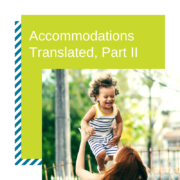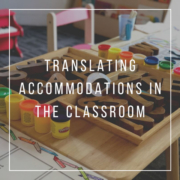Accommodations Translated, Part II
In “Accommodations Translated Part I,” we introduced several key distinctions. We explained the four categories: setting, presentation, response, and timing. We also discussed the difference between accommodations and modifications, as they relate to special education services. To continue our parent’s guide to classroom accommodations, we hope to explain a few of the more ambiguous terms, while still stressing the importance of open communication between parents and teachers when discussing IEP/504 accommodations.
| What is it? | When is it used? | How is it helpful? |
| Flash pass | Flash passes are used as a discreet means of signaling a student’s need to leave the classroom to take a “brain break” or cool down. They can be used for students with emotional disabilities, anxiety, ADHD, and health issues, among other things. | Flash passes allow students the opportunity to hit the “reset” button during times of stress or when emotionally triggered. Flash passes often allow students to quietly leave to visit a break/cool down room, nurse’s office, counselling department, or resource room. It helps students self-assess and regulate their emotions by providing them with an additional means of calming down before a breakdown. |
| Scribe and/or oral response | When a disability complicates a student’s ability to write, like dysgraphia, for example, a human scribe means that a teacher or support staff will write the response or passage as the student dictates. The response is the student’s genuine response, but without the complication of physically writing it down. | This ensures that students are evaluated on their knowledge and understanding, just like every other student, but without the barrier of their disability. This accommodation also helps to build self-esteem because students’ ability to respond is not limited by their capacity to write. |
| Reduced workload | Reduced workload is tricky because, if the learning goals or standards are reduced, this becomes a modification, not an accommodation. However, many students with identified learning disabilities may benefit from the accommodation, so long as the learning objectives are still assessed and met. If a student has a condition that limits his or her ability to maintain focus for lengthy periods of time, a reduced workload will help. | Essentially, with reduced workload, students are expected to meet the same objectives by using the same methods, but will be required to produce fewer examples, answers, paragraphs, etc. For instance, a student with PANDAS, for whom extended focus could trigger physical symptoms, teachers may require that student to write a 3–paragraph essay, as opposed to 5 paragraphs. The student is still accountable for meeting writing standards for introducing, supporting, and concluding a topic; however, the additional body paragraphs are not required to demonstrate mastery. |
| Chunking | Chunking assignments and tasks is used when students struggle to tackle multi-step tasks or projects due to attention issues, executive functioning deficits, etc. While chunking is a “best practice,” meaning that teachers use this routinely for all students, it is not guaranteed unless documented in a student’s IEP. For a biology project or argumentative essay, for example, a teacher would break down the assignment into manageable daily/weekly steps. | Chunking works to benefit students in several ways. It makes the complex task seem more manageable and less daunting by breaking it into practical, feasible steps. It also helps students explicitly organize the workload by telling them in what order the steps should be completed. This is especially helpful for students with executive functioning deficits, because they often lack the skills necessary to organize complex tasks independently. Finally, chunking helps students manage their time with realistic checkpoints and soft due dates. Teachers are able to mitigate any struggles during the learning process and help simplify steps if necessary. |
| Extended time | Extended time, as it sounds, allows students to have additional time to complete and/or submit assessments and assignments. This accommodation is frequently used when students struggle with attention issues, organization, processing disorders, etc. | Additional time, which could mean anything from 50-100% extended time past the due date, is meant to ensure that students are evaluated based on their abilities without their disability interfering. One major aspect that the IEP team will need to discuss is how the accommodation will be used. Parents, teachers, and the student should agree upon how extended time will be used. Will it apply to homework assignments, or just major tasks? How will that look during assessments? How will the student request extended time? At what point in the process of a project or essay should the student ask for extended time? |





